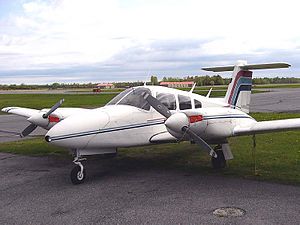- Counter-rotating propellers
-
Not to be confused with Contra-rotating propellers.
Counter-rotating propellers 
Opposite propeller blade section can be clearly seen on this Piper PA-44 Seminole Counter-rotating propellers, found on twin- and multi-engine propeller-driven aircraft, spin in directions opposite one another.
The propellers on both engines of most conventional twin-engined aircraft spin clockwise (as viewed from the pilot seat). Counter-rotating propellers generally spin clockwise on the left engine and counter-clockwise on the right. The advantage of such designs is that counter-rotating propellers balance the effects of torque and p-factor, eliminating the problem of the critical engine.
In designing the Lockheed P-38, the decision was made to reverse the counter-rotation such that the "tops" of the propeller arcs move outwards, away from each other. Tests on the initial XP-38 prototype demonstrated greater accuracy in gunnery with the unusual configuration. The German World War II Henschel Hs 129 ground attack aircraft, Heinkel He 177 heavy bomber and Messerschmitt Me 323 transport's counter-rotating powerplants used the same rotational "sense" as the production P-38 did.
Drawbacks of counter-rotating propellers come from the fact that, in order to reverse sense of rotation of one propeller, a gearbox needs to be used or the engine or engine installation must be different. This may increase weight (gearbox), or maintenance and spare parts costs for the engines and propellers, as different spare parts need to be produced in lower numbers, compared to a conventional installation.
Counter-rotating propellers should not be confused with contra-rotating propellers that share common axes.
The following aircraft have counter-rotating propellers:
Single engine, chain driven propellers :
Twin-engine, 1 engine per wing :
- de Havilland Hornet
- Lockheed P-38 Lightning
- Heinkel He 177 Greif (fourth prototype onwards)
- Piper PA-31 Navajo
- Piper PA-34 Seneca
- Piper PA-39 Twin Comanche
- Piper PA-40 Arapaho
- Piper PA-44 Seminole
- Cessna T303 Crusader
- Beech BE-76 Duchess
At least four engines, two or more on each wing :
- Messerschmitt Me 323 Gigant transport
- Airbus A400M - first plane with propellers that counter-rotate on each wing
See also
- Tiltrotor
- Counter-rotating rotors
- Intermeshing rotors
- Screw-propelled vehicle
Aircraft gas turbine engine components, systems and terminology Gas turbines TypesPropfan · Turbofan · Turbojet · Turboprop · Turboshaft
Mechanical
componentsAfterburner (reheat) · Axial compressor · Centrifugal compressor · Combustor · Constant Speed Drive · Propelling nozzle · Turbine blade
TerminologyPropellers ComponentsTerminologyAutofeather · Blade pitch · Contra-rotating · Constant speed · Counter-rotating · Proprotor · Scimitar propeller · Variable pitch
Engine
instrumentsAnnunciator panel · Electronic Centralised Aircraft Monitor (ECAM) · Electronic Flight Instrument System (EFIS) · Engine Indicating and Crew Alerting System (EICAS) · Flight data recorder · Glass cockpit
Engine controls Autothrottle · Full Authority Digital Engine/Electronics (FADEC) · Thrust lever · Thrust reversal
Fuel and induction
systemsOther systems Air-start system · Auxiliary power unit (APU) · Bleed air system · Hydraulic system · Ice protection system
Lists relating to aviation General Aircraft (manufacturers) · Aircraft engines (manufacturers) · Airlines (defunct) · Airports · Civil authorities · Museums · Registration prefixes · Rotorcraft (manufacturers) · TimelineMilitary Accidents/incidents Records Categories:- Aviation stubs
- Propellers
- Aircraft engines
Wikimedia Foundation. 2010.
